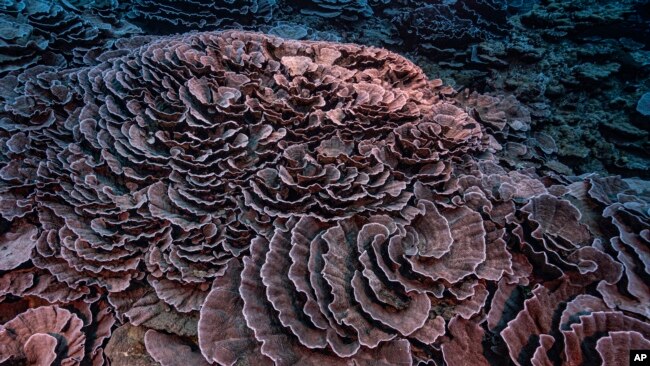仏領ポリネシアタ・ヒチ島沖で珍しい世界最大級のサンゴ礁
気候変動によりサンゴの白化現象、あれから保護は進んだのでしょうか?
通常サンゴは浅瀬に生息することが多いそうですが、今回の報告では深さ35メートルから70メートル、潜水時間も200時間と比較的深い場所で発見されました。
世界最大級と言われるサンゴ礁は長さ約3キロ、幅最大65メートルで、昨年11月に発見されたそうです。
サンゴの群体は直径が最大2メートルで、写真で見ると、バラの花びらのような形をしていますね。
その発見された深さと形状、とても珍しいとのこと。
VOAで英語を学び、世界の今を見つめましょう!!
珍しいサンゴ礁を研究する科学者たち (和訳)
Scientists Study Unusual Coral Reef
January 23, 2022

南太平洋のタヒチ島付近で発見された珍しいサンゴ礁を、このほど研究者たちが調査しました。このサンゴ礁は、このような深さで発見されたものとしては最大級であり、気候変動や人間活動の影響を受けていないようです。
ユネスコが支援するダイビング
今回発見されたサンゴ礁は3キロメートルに及びます。昨年末、ユネスコが支援するダイビングで調査されました。世界の地図に載っているサンゴは浅瀬にあることが多いのですが、このサンゴはと深かったのです。
このような深さの探索は困難です。深く潜れば潜るほど、安全に潜れる時間は短くなます。ダイビングチームは特別な空気タンクを持ち、200時間潜水してサンゴ礁を調査し、写真撮影、測定、サンゴのサンプル採取を行いました。
サンゴは小さな動物で、世界中の海で成長し、サンゴ礁を形成しています。
このサンゴ礁は、多くの研究者があまり時間をかけてこなかった場所にあると、元米国海洋大気庁のマーク・イーキン氏は述べています。
「このような場所に技術が適用されれば、このような発見が増えるでしょう。」とイーキン氏は言いました。「どこかでもっと大きなものが見つかるかもしれませんが、ここは常に珍しいサンゴ礁であり続けると思います。」
レクリエーションダイブと今後の研究
レティシア・ヘドゥアン氏は、数カ月前に地元のダイビンググループのレクリエーションダイビングで初めてサンゴを見たそうです。レクリエーションとは、楽しむために行うという意味です。
「初めて行ったとき、すごい、あのサンゴ礁を研究しなければ と思いました。あのサンゴ礁には何か特別なものがあります。」とヘドゥアン氏は言っています。
彼女は、フランス領ポリネシアのモーレアにあるフランス国立科学研究センターの研究者です。
ヘドゥアン氏は、サンゴが健康そうで、2019年の白化現象に影響されていないように見えることに気づきました。白化現象とは、サンゴが色を失い、白くなってしまうことです。
世界中で、珊瑚礁は乱獲や汚染でダメージを受けています。気候変動も、新しく発見されたサンゴ礁の近くの地域を含め、サンゴを傷つけています。
2009年から2018年の間に、世界のサンゴの14%が死滅したと、グローバル・サンゴ礁モニタリング・プロジェクトによる2020年の報告書は述べています。
最近トンガで起きた火山爆発が太平洋に大きな波を起こしましたが、タヒチ沖のサンゴ礁には影響がないと、ヘドゥアン氏は言っています。
ヘドゥアン氏は、今回の研究が、気候変動や人間活動によるサンゴ礁のダメージがない理由を専門家が理解するのに役立つことを期待しています。また、深海のサンゴが海の中でどのような役割を担っているのか、より深く理解できるようになればと願っています。今後数カ月間、さらに多くのダイビングが予定されています。
ジュリアン・バルビエール氏は、ユネスコの海洋政策と地域調整の責任者です。
バルビエール氏は、「私たちは海についてほとんど何も知らないし、記録すべきこと、測定すべきことはまだたくさんあります」と語っています。
Scientists Study Unusual Coral Reef
Researchers recently examined an unusual coral reef that was discovered near Tahiti in the South Pacific Ocean. The reef is thought to be one of the largest found at such depths and seems untouched by climate change or human activities.
Dive supported by UNESCO
The newly found reef stretches 3 kilometers. It was studied late last year during a dive supported by UNESCO. Unlike most of the world’s mapped corals, which are found in shallow waters, this one was deeper — between 35 meters to 70 meters.
Such depths are difficult to explore. The deeper a diver goes underwater, the shorter the amount of time he or she can safely spend at each depth. The dive team had special air tanks and did 200 hours of diving to study the reef. The team took photographs, measurements and samples of the corals.
Corals are tiny animals that grow and form reefs in oceans around the world.
The reef is in a place where many researchers have not spent a lot of time, said Mark Eakin, formerly of the National Oceanic and Atmospheric Administration.
“We’ll be seeing more of these discoveries as the technology is applied to these locations,” said Eakin. “We may find some bigger ones somewhere, but I think this is always going to be an unusual reef.”
Recreational dives and future research
Laetitia Hédouin said she first saw the corals months earlier with a local diving group that was on a recreational dive. Recreational is a term that means done for enjoyment.
“When I went there for the first time, I thought, ’Wow — we need to study that reef. There’s something special about that reef,” said Hédouin.
She is a researcher at the French National Center for Scientific Research in Moorea, French Polynesia.
Hédouin noticed that the corals looked healthy and did not appear to be affected by a bleaching event in 2019. A bleaching event is when corals lose their colors and turn white.
Around the world, coral reefs have been damaged from overfishing and pollution. Climate change is also hurting corals, including those in areas near the newly discovered reef.
Between 2009 and 2018, 14 percent of the world’s corals were killed, says a 2020 report by the Global Coral Reef Monitoring Project.
The recent volcanic explosion in Tonga that created large waves across the Pacific has not affected the reef off Tahiti, said Hédouin.
Hédouin hopes the recent research can help experts understand why the reef has not been damaged by climate change and human activities. She also hopes scientists can better understand what part these deeper corals might play in the ocean. More dives are planned in the coming months.
Julian Barbière is the head of UNESCO’s marine policy and regional coordination.
Barbière said, “We know very little about the ocean, and there’s still so much that needs to be recorded, needs to be measured."
Words in This Story
coral reef – n. : a long line of coral that lies in the water – usually in warm, shallow water
shallow – adj. having a small distance to the bottom from the surface or highest point
location – n. a place or position
marine – adj. of or relating to the sea or the plants and animals that live in the sea